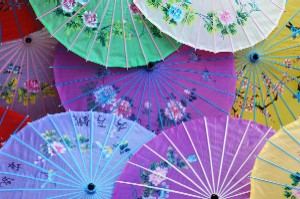Parasols
Antiques Trivia, Clothing Trivia “It will be Summer – eventually.
“It will be Summer – eventually.
Ladies – with parasols –
Sauntering Gentlemen – with Canes –
And little Girls – with Dolls”
Emily Dickinson, the famous poet, wrote these lines in the charming Victorian age when wealthy young ladies often used parasols in summer to protect their delicate skin from the sun. If a lady had fair skin this meant that she didn’t have to work outdoors like the poor so this was considered a sign of privilege. On the other hand, using an umbrella was a sign that a lady was poor because she couldn’t afford to hire or own a carriage. ‘Showing off’ by riding in a carriage with the top down whilst holding a parasol was fashionable amongst young Victorian ladies and certainly one way to parade their pretty clothes.
The parasol replaced the previously stylish bonnets which were now associated with old ladies and unfashionable spinsters and was certainly a more elegant, alluring item. Young women usually owned two – one in black silk and one in white.
Parasols and umbrellas were not a Western invention but originated in ancient times. They were used in many different societies, including the Chinese, the Egyptian and the Greek. Their use usually signified a mark of high rank. In Egypt, for example, umbrellas were a religious symbol showing that there was a vault of heaven over the king. Here they usually consisted of a fan of palm leaves or colored feathers over a long handle. Slaves often bore them to shade their royal master.
In Greece, as in Victorian England and America, the parasol was used by fashionable ladies. In the feast of Athene Sciras, the goddess of wisdom, white parasols were borne by her priestesses.
The lovely silk parasol so popular in the nineteenth century, however, is thought to have originated in China. It was brought to Europe by the explorers and became chic in France in the sixteenth century. Mary, Queen of Scots, who was married to the French Dauphin, owned a very pretty one of crimson satin trimmed with gold tassels.
Catherine of Braganza, the wife of Charles 11, brought an umbrella with her to England and by the late 1600’s umbrellas were used by both sexes in England so that they could shelter from the rain.
However, parasols didn’t become a fashionable item for women until the Victorian era. As parasols were made of silk, brushed feathers or lace, with lovely handles, many women found them beautiful as well as useful items. They could even be used to hide defects from attractive men. Emma Hamilton, Nelson’s mistress, loved to take pink parasols on her walks because they cast a rosy glow on her skin which made her look more youthful.
Unfortunately, these elegant items began to fall out of fashion in the 1920’s. This is when young and beautiful people, such as F. Scott Fitzgerald began the trend of sun-bathing on the Riviera. Soon it became the fashion to have a tan because it was a symbol of wealth. Lazing luxuriously in the sun showed that one had the money to be idle! Fair skins began to be regarded with distaste.
Parasols, unfortunately, have remained unfashionable although many women use umbrellas to shade their skin from the sun in this age of skin-cancer. Many do not like to run the risk of ridicule by using an item associated with the Victorian era and appearing eccentric. This is a great pity because the parasol is such a useful, elegant item.
“Till Summer folds her miracle
As Women – do – their Gown-
Of Priests – adjust the Symbols –
When Sacrament – is done -“
